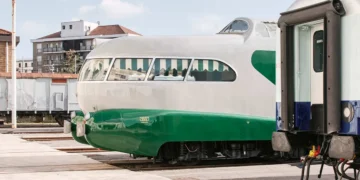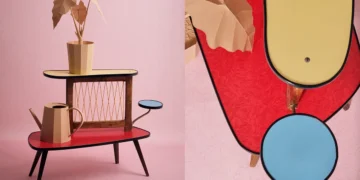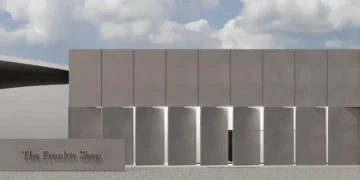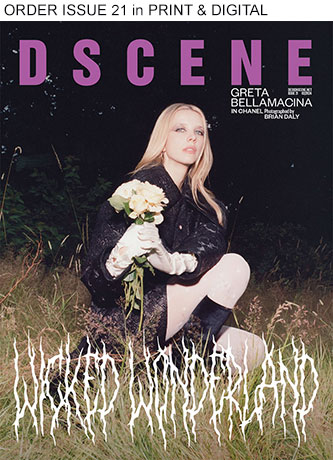
Now in its fourth edition, Prada Frames once again proved that design thinking gains momentum when it travels across disciplines. This year’s symposium, curated by Formafantasma under the theme In Transit, explored infrastructure through a cultural and critical lens, examining not just how people and goods move, but how systems of power, surveillance, and trade shape that movement. DSCENE Magazine was there to witness the conversations unfold across one of the most inspired programs of Milan Design Week 2025.
But what truly defined this year’s edition wasn’t only the intellectual scope, it was the setting. The sessions took place in two historically charged spaces: the newly restored Arlecchino Train and the Padiglione Reale of Milano Centrale. Originally designed by Gio Ponti and Giulio Minoletti in the 1950s, the Arlecchino radiates mid-century elegance with its panoramic lounges and aerodynamic exterior. Cruising through Milan on a train once meant for glamour and speed, guests were reminded that mobility is never just physical, it’s aesthetic, emotional, and deeply political.

The Padiglione Reale, typically closed to the public, offered another layer of meaning. Once a waiting room for royalty and heads of state, the space became a platform for open discourse, repurposing grandeur into accessibility. Set inside this architectural relic, lectures on global logistics, digital infrastructures, and systems of control took on new resonance, linking past authority with contemporary urgency.

This year’s symposium offered an ambitious and rigorously curated exploration of infrastructure, not just as a system of transport and logistics, but as a powerful force shaping global life. The lecture series unfolded over three days, contextualized by design critic Alice Rawsthorn and featuring a multidisciplinary cast of speakers including artists, theorists, scientists, and architects. Across sessions, the conversations addressed how movement, of goods, people, data, and power, is choreographed, restricted, and reimagined.

The symposium opened with reflections on digital infrastructures. Kate Crawford and Marina Otero examined the often-invisible frameworks that support AI and data-driven technologies, connecting cloud systems to labor exploitation, urban displacement, and environmental strain. In another standout session, Hito Steyerl and Samia Henni discussed the relationship between surveillance and control, drawing lines between colonial fortifications and today’s algorithmic borders. Their talks mapped how infrastructure has always served as a tool of governance, shaping who gets to move and who must remain still.
Trade and logistics formed another major thread. Rose George and Jesse LeCavalier dissected the mechanics of global commerce, from port systems and container ships to last-mile delivery networks. Their session unpacked how these physical systems underpin entire economies, while also exposing vulnerabilities in a hyper-connected world. Meanwhile, talks on migration and resistance, led by Lorenzo Pezzani and Marta Foresti, turned the lens to human mobility. They traced how policy, politics, and technology shape the experience of movement for displaced populations, raising questions about borders, belonging, and agency.

Additional sessions pushed the boundaries of infrastructure into unexpected territories. Nelly Ben Hayoun-Stépanian and Giacomo Abbruzzese explored speculative storytelling as a way to challenge dominant systems. Paola Antonelli and Nicola Twilley turned to food and refrigeration, revealing the invisible networks that govern what we eat and how we store it. Tung-Hui Hu, Metahaven, Julia Watson, and Ersilia Vaudo extended the inquiry into fiber-optic railways, space infrastructure, and ecological intelligence, showing how the past, present, and future of movement remain deeply entangled.
Throughout the program, the lectures resisted simple narratives. Instead, they embraced complexity, contradiction, and debate, inviting the audience to question what infrastructure really is, and who it serves. Set against the moving landscape of the Arlecchino train and the layered history of the Padiglione Reale, the ideas felt rooted yet constantly in motion.

From surveillance infrastructures and migration routes to edible systems and fiber-optic railways, Prada Frames: In Transit pushed attendees to rethink the built environment as a living matrix. The space between panel and participant felt narrow, the conversations intimate, thanks in no small part to the thoughtful programming and immersive settings.
Whether listening to insights roll in from the plush seats of the Arlecchino or watching sunlight hit the ornate walls of the Padiglione Reale, this year’s Prada Frames proved that movement, when coupled with meaning, can be one of design’s most powerful tools.




















This was stunning ! I had the chance to see the beautiful train at centrale train station ! Gio Ponti was a true master of his craft ❤️